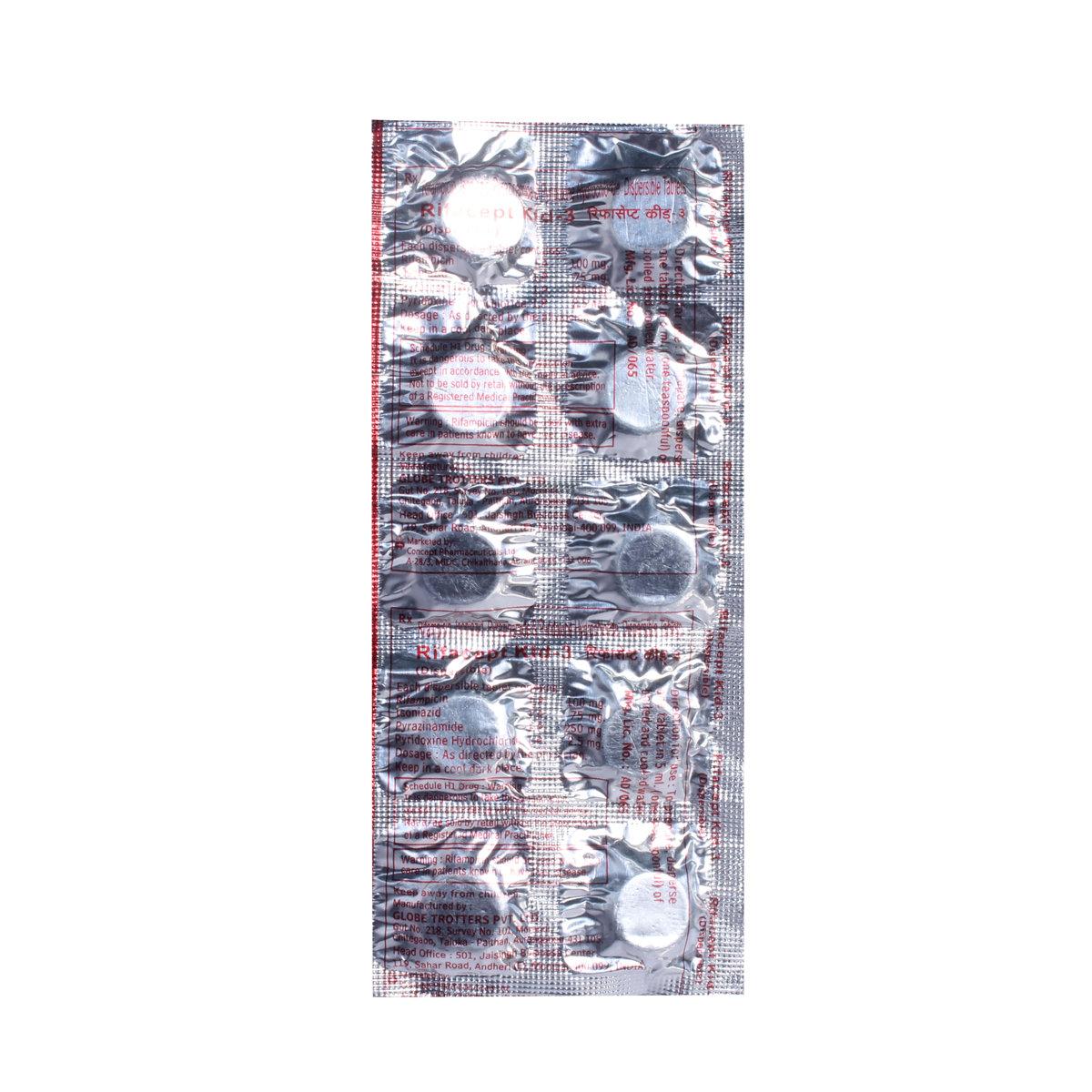Rifampicin+isoniazid+pyrazinamide+pyridoxine Hydrochloride
About Rifampicin+isoniazid+pyrazinamide+pyridoxine Hydrochloride
Rifampicin+isoniazid+pyrazinamide+pyridoxine Hydrochloride belongs to the group of medicines called anti-tuberculosis drugs primarily used to treat and prevent tuberculosis. Tuberculosis is an infectious disease that mainly affects the lungs, but it can also spread to other body parts such as kidneys, brain, spine, and bone marrow.
Rifampicin+isoniazid+pyrazinamide+pyridoxine Hydrochloride is a combination of four drugs: Isoniazid, Pyrazinamide, Pyridoxine hydrochloride (vitamin B6), and Rifampicin. Isoniazid inhibits the biosynthesis of mycolic acid, which is the major component of the bacterial cell wall. Pyrazinamide is an antibiotic that works by stopping the growth of bacteria that cause tuberculosis. Pyridoxine hydrochloride treats nerve damage (neuritis) caused by tuberculosis. Rifampicin inhibits DNA-dependent RNA polymerase activity in the bacteria.
Your doctor will decide the dose and duration based on the severity of your disease. Common side effects of Rifampicin+isoniazid+pyrazinamide+pyridoxine Hydrochloride include muscle/joint pain, nausea, vomiting, rash, dark-coloured urine, weakness, dry mouth, stomach pain, and upset stomach. These side effects are not familiar to everyone and vary individually. If you notice any side effects that are not manageable, please consult your doctor.
Avoid foods and drinks that contain histamine or tyramine, such as cured meat, matured cheese, soya, tuna, salmon, mackerel, wine, and beer while taking Rifampicin+isoniazid+pyrazinamide+pyridoxine Hydrochloride as they may interact. Maintain a gap of one hour between Rifampicin+isoniazid+pyrazinamide+pyridoxine Hydrochloride and antacid medicines. Rifampicin+isoniazid+pyrazinamide+pyridoxine Hydrochloride may cause dizziness, and vision problems, so drive with caution. Let your doctor know if you are pregnant, planning to conceive, or are a breastfeeding mother. Avoid consuming alcohol with Rifampicin+isoniazid+pyrazinamide+pyridoxine Hydrochloride as it might lead to liver problems. Rifampicin+isoniazid+pyrazinamide+pyridoxine Hydrochloride should be used in children only when the doctor has prescribed it.
Uses of Rifampicin+isoniazid+pyrazinamide+pyridoxine Hydrochloride
Medicinal Benefits
Rifampicin+isoniazid+pyrazinamide+pyridoxine Hydrochloride contains Isoniazid, Pyrazinamide, Pyridoxine hydrochloride (vitamin B6), and Rifampicin. Isoniazid inhibits the biosynthesis of mycolic acid, which is the major component of the bacterial cell wall. Pyrazinamide is an antibiotic that works by stopping the growth of bacteria that cause tuberculosis. Pyridoxine hydrochloride (vitamin B6) treats nerve damage (neuritis) caused by tuberculosis. Rifampicin inhibits DNA-dependent RNA polymerase activity in the bacteria. Together, Rifampicin+isoniazid+pyrazinamide+pyridoxine Hydrochloride kills Mycobacterium tuberculosis which causes TB (tuberculosis).
Directions for Use
Storage
Side Effects of Rifampicin+isoniazid+pyrazinamide+pyridoxine Hydrochloride
- Muscle/joint pain
- Nausea
- Vomiting
- Rash
- Dark coloured urine
- Weakness
- Dry mouth
- Stomach pain
- Upset stomach
Drug Warnings
Avoid foods and drinks containing histamine or tyramine, such as cured meat, matured cheese, soya, tuna, salmon, mackerel, wine, and beer, while taking Rifampicin+isoniazid+pyrazinamide+pyridoxine Hydrochloride as they might cause interaction. Maintain a gap of one hour between Rifampicin+isoniazid+pyrazinamide+pyridoxine Hydrochloride and antacid medicines. Consult your doctor before taking Rifampicin+isoniazid+pyrazinamide+pyridoxine Hydrochloride if you are pregnant. Breastfeeding mothers should speak to a doctor before they take Rifampicin+isoniazid+pyrazinamide+pyridoxine Hydrochloride since it passes into breast milk. Rifampicin+isoniazid+pyrazinamide+pyridoxine Hydrochloride may cause dizziness, and vision problems, so drive with caution. Avoid alcohol consumption while taking Rifampicin+isoniazid+pyrazinamide+pyridoxine Hydrochloride as it could lead to increased liver damage. Store Rifampicin+isoniazid+pyrazinamide+pyridoxine Hydrochloride below 25°C away from direct sunlight.
Drug Interactions
Drug-Drug Interaction: Rifampicin+isoniazid+pyrazinamide+pyridoxine Hydrochloride may interact with antibiotics (erythromycin), pain killers (acetaminophen), anti-diabetic drugs (insulin isophane), anti-HIV drugs (saquinavir, ritonavir), supplements (ergocalciferol), gout medicines (probenecid, sulfinpyrazone), and oral contraceptives.
Drug-Food Interaction: Do not consume alcohol while taking Rifampicin+isoniazid+pyrazinamide+pyridoxine Hydrochloride as it could lead to increased dizziness and liver damage. Avoid foods and drinks containing histamine or tyramine such as cured meat, matured cheese, soya, tuna, salmon, mackerel, wine, and beer while taking Rifampicin+isoniazid+pyrazinamide+pyridoxine Hydrochloride as they might cause interaction.
Drug-Disease Interaction: Rifampicin+isoniazid+pyrazinamide+pyridoxine Hydrochloride may interact with colitis (inflammation in the lining of the colon), peripheral neuropathy (numbness and pain in hands and feet), porphyria, hemodialysis, diabetes, gout (high uric acid), liver toxicity, dialysis, optic neuritis (vision problems), kidney, and liver dysfunction.
Drug-Drug Interactions Checker List:
Safety Advice

Alcohol
unsafeAvoid alcohol consumption while taking Rifampicin+isoniazid+pyrazinamide+pyridoxine Hydrochloride. Alcohol intake, along with Rifampicin+isoniazid+pyrazinamide+pyridoxine Hydrochloride, may cause increased liver damage. Please consult your doctor for more information.

Pregnancy
cautionPlease consult your doctor if you are pregnant, or planning a pregnancy; your doctor will prescribe Rifampicin+isoniazid+pyrazinamide+pyridoxine Hydrochloride only if the benefits outweigh the risks.

Breast Feeding
unsafeRifampicin+isoniazid+pyrazinamide+pyridoxine Hydrochloride is not recommended for use during breastfeeding since it is excreted into the breast milk and may harm your baby. However, please consult your doctor before taking Rifampicin+isoniazid+pyrazinamide+pyridoxine Hydrochloride if you are a breastfeeding mother.

Driving
unsafeRifampicin+isoniazid+pyrazinamide+pyridoxine Hydrochloride may cause dizziness, vision problems, numbness and tingling sensation in hands and feet. Do not drive or operate machinery if you experience these symptoms.

Liver
cautionPlease consult your doctor since Rifampicin+isoniazid+pyrazinamide+pyridoxine Hydrochloride should be used with caution in patients with liver impairment/liver disease. Regular monitoring of liver function tests is also advised.

Kidney
cautionPlease consult your doctor since Rifampicin+isoniazid+pyrazinamide+pyridoxine Hydrochloride should be used with caution in patients with kidney impairment/kidney disease. Your doctor may adjust the dosage in case of renal dysfunction.

Children
safe if prescribedRifampicin+isoniazid+pyrazinamide+pyridoxine Hydrochloride is recommended in children only when the doctor has prescribed it.
Habit Forming
Diet & Lifestyle Advise
- Pineapple juice might help soothe the symptoms of cough and cold. It also has anti-inflammatory and mucolytic properties.
- Foods rich in vitamin C, such as kiwi, broccoli, and bell pepper, help improve the immune system.
- Avoid processed and fried foods.
- Warm ginger tea or warm soup can help in providing relief from a cough.
- Avoid foods and drinks, such as cured meat, matured cheese, soya, tuna, salmon, mackerel, wine, and beer.
- Quit smoking and avoid alcohol consumption.
Patients Concern
Disease/Condition Glossary
Tuberculosis (TB): Tuberculosis is an infectious disease that affects the lungs, but it could also spread to other body parts such as the kidneys, brain, spine, and bone marrow. Tuberculosis is caused by a bacteria named Mycobacterium tuberculosis. It is a contagious disease that can spread to others through small droplets released into the air by a person suffering from tuberculosis. Symptoms include a cough that lasts for a few weeks, pain while coughing or normal breathing, unexplained fatigue, fever, night sweats, and loss of appetite and weight. People who smoke or consume alcohol, people diagnosed with HIV, and immune system problems are more likely at risk of developing active TB.
FAQs
Rifampicin+isoniazid+pyrazinamide+pyridoxine Hydrochloride contains Isoniazid, Pyrazinamide, Pyridoxine hydrochloride (vitamin B6), and Rifampicin. Rifampicin+isoniazid+pyrazinamide+pyridoxine Hydrochloride interferes with the growth of tuberculosis causing bacteria and killing them. Thus Rifampicin+isoniazid+pyrazinamide+pyridoxine Hydrochloride effectively treats TB (tuberculosis).
Rifampicin+isoniazid+pyrazinamide+pyridoxine Hydrochloride may cause discolouration of teeth, sweat, urine, sputum (phlegm), saliva, or tears. The colour in tears may last for some time even after you stop taking Rifampicin+isoniazid+pyrazinamide+pyridoxine Hydrochloride. Do not worry, as it is a common side-effect of Rifampicin+isoniazid+pyrazinamide+pyridoxine Hydrochloride.
Rifampicin+isoniazid+pyrazinamide+pyridoxine Hydrochloride can affect live vaccines like typhoid vaccine and decrease their effectiveness. Therefore, please consult a doctor before you start using Rifampicin+isoniazid+pyrazinamide+pyridoxine Hydrochloride if you are about to undergo any vaccinations.
Take the missed dose of Rifampicin+isoniazid+pyrazinamide+pyridoxine Hydrochloride as soon as possible. However, if it is time for the next dose, skip the missed dose and return to your regular dosing schedule.
Available Medicines for
Rifampicin+isoniazid+pyrazinamide+pyridoxine Hydrochloride




